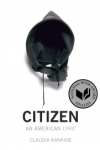When I come across a brilliant writer pulling off second person brilliantly, I’m tempted to think it’s not that special. It’s just another tool in the writer’s toolbox that I might make use of one day. Maybe. It’s like when author Ehud Havazelet writes in The New York Times, “You ask, so how different really is Second Person? Isn’t it just a choice of color, say, or tonality, the way a composer might choose whatever key she likes to compose a piece in?”
But when I come across it and it’s done well, I also feel a great sense of satisfaction. The writer has used the second person narrative voice, and I have read it, and we have become co-conspirators in a rare occurrence.
In Citizen: An American Lyric, poet Claudia Rankine draws her readers into the book’s scenes and stories using the second person, creating a more personal experience that might catch her readers off guard.

The rain this morning pours from the gutters and everywhere else it is lost in the trees. You need your glasses to single out what you know is there because doubt is inexplicable; you put on your glasses. The trees, their bark, their leaves, even the dead ones, are more vibrant wet. Yes, and it’s raining. Each moment is like this—before it can be known, categorized as similar to another thing and dismissed, it has to be experienced, it has to be seen… The moment stinks. Still you want to stop looking at the trees. You want to walk out and stand among them. And as light as the rain seems, it still rains down on you.
In this interior scene, readers are invited to make the text their own thoughts. They can imagine the rainy morning and what it would be like to look out a window to discern the trees’ details. And, readers can better connect with the idea of experiencing something through seeing because of the vivid image painted using the second person.

Because of your elite status from a year’s worth of travel, you have already settled into your window seat on United Airlines, when the girl and her mother arrive at your row. The girl, looking over at you, tells her mother, these are our seats, but this is not what I expected. The mother’s response is barely audible—I see, she says. I’ll sit in the middle.
Because readers don’t know the race, ethnicity, or appearance of the person already seated in the airplane when the girl and her mother arrive, they can again easily imagine themselves in that row. Use of the second person further facilitates this dynamic. Also, because of the lack of clarity about the person interacting with the girl and her mother, readers’ assumptions are exposed; while they imagine what this person looks like, their own biases may be more apparent.
In another scene Rankine writes, “And when the woman with the multiple degrees says, I didn’t know Black women could get cancer, instinctively you take two steps back though all urgency leaves the possibility of any kind of relationship as you realize nowhere is where you will get from here.” Rankine’s readers know that the person who takes two steps back is a Black woman. They know the woman speaking to her is not Black and is at least intelligent enough to earn more than one degree. In one quick slice, it is made clear: intelligence does not shield a person from painful ignorance.
By the end of our experience with Rankine, we understand that the second person can help remove illusions—it can switch people’s points of view. And that’s something we writers may not have realized was so within our power to do, simply by choosing, with care, which perspective to use.
BUY ‘HOW TO WRITE A FORM POEM’ NOW!
Try It
Seeing Rankine’s use of second person narrative voice makes me want to give it a try and see what happens. Below, I’ve provided the before and after of an excerpt from a piece of fiction I’m writing (which is loosely based on a personal experience). I originally wrote this section in first person, but I thought I’d see how it works in second person.
What do you think? How does your sense of the piece change?
Before
I will never forget the tiny, mirrorless bathroom that looked like it had been swallowed by lime-green ceramic tile. There was a white pedestal sink, a toilet, and a walk-in shower with no door or shower curtain. I only showered twice that week because a nurse aid had to be present. I cried the first time. The woman who watched me—I can’t remember which woman it was—sat on a stainless stool in front of the door and thumbed through a magazine while glancing up every few seconds to make sure I wasn’t drowning myself or harming myself in some way. After I undressed, I stood under the water and covered my body with my arms and hands. I didn’t know which direction to face—I didn’t know which direction would be less humiliating.
After
You will never forget the tiny, mirrorless bathroom that looked like it had been swallowed by lime-green ceramic tile. There was a white pedestal sink, a toilet, and a walk-in shower with no door or shower curtain. You only showered twice that week because a nurse aid had to be present. You cried the first time. The woman who watched you—you can’t remember which woman it was—sat on a stainless stool in front of the door and thumbed through a magazine while glancing up every few seconds to make sure you weren’t drowning yourself or harming yourself in some way. After you undressed, you stood under the water and covered your body with your arms and hands. You didn’t know which direction to face—you didn’t know which direction would be less humiliating.
Your turn
Have you tried writing in second person? How did it go? As an experiment, try rewriting a first-person vignette into second person.
Photo by Pabak Sarkar, Creative Commons license via Flickr. Post by Charlotte Donlon.
- Read Like a Writer: Second Person Narrative Voice in Claudia Rankine’s “Citizen: An American Lyric” - December 5, 2018
- Read Like a Writer: C.E. Morgan’s Personification Technique in “All the Living” - October 17, 2018
- Read Like a Writer: Mary Oliver’s “Upstream” - September 5, 2018



Sandra Heska King says
Something I wrote seven years ago from the hospice house where my sister, dad, and I lived with my mom for five weeks . She passed from a GBM a couple of days after Thanksgiving.
They say they heard me snore all the way to the Netherlands. But I don’t believe them. Later when my dad and sister have left with the laptop, I sit and listen to the house sounds.
The man in room seven is playing his guitar and singing. Then I hear guitar and flute together. Or is that a recorder? His sister must be visiting. I hear a door close and the hum of the furnace and the rattle of dishes in the kitchen. I hear my sister laugh down the hall. This place is beginning to feel like home.
I head down to the lobby and settle in a wingback to puzzle the pieces. My head droops lower toward the table, and my arms slip against the glass top. I jerk awake and bend to pick up the pieces from the floor. I slide them back into place in the puzzle. This doing nothing, this waiting, is exhausting.
Later all three of us gather around the table. My sister says someone has touched her hair. But we are alone.
…..
They say they heard you snore all the way to the Netherlands. But you don’t believe them. Later when your dad and sister have left with the laptop after the Skype call, you sit and listen to the house sounds.
The man in room seven is playing his guitar and singing. Then you hear guitar and flute together. Or is that a recorder? His sister must be visiting. You hear a door close and the hum of the furnace and the rattle of dishes in the kitchen. You hear your sister laugh down the hall. This place is beginning to feel like home.
You head down to the lobby and settle in a wingback to puzzle the pieces. Your head droops lower toward the table, and your arms slip against the glass top. You jerk awake and bend to pick up the pieces from the floor. You slide them back into place in the puzzle. This doing nothing, this waiting, is exhausting.
Later all three of you gather around the table. Your sister insists someone has touched her hair. But the three of you are alone.
L.L. Barkat says
I love how you explored with this, Sandra. The whole first section (in the second version) feels more floaty, ethereal, and I like that a lot.
Strangely, I like the very last bit (in the first version) better—the part about your sister. It feels more terribly intimate, in a way that deeply captures the twin feelings of grief and surprise, with the surprise remaining ambiguous (we aren’t sure if it’s a good surprise or a troubling one… it feels almost more troubling than anything else).
So glad you shared.
Sandra Heska King says
Thanks, Laura. There’s more to the story. I just stopped there. So in case you’d like to know the rest of the story…
Our favorite aide (Jackie) had crept into the room while we were focused on the puzzle. She hid behind the wingback chair and ruffled my sister’s hair–two or three times before she showed herself. (My sister was starting to freak out.)
Jackie told us then about the lady in room five who had several tables in her room and made things. She was in pain but would still go out and buy things to bring back and make more things. She’d move from table to table making things.
Jackie told us about the man, months later, in room five who complained about not being able to sleep because “she” kept moving from table to table “making things.”
We asked Jackie about deer stories we’d heard, and she just shrugged and said there were a lot of things that happened there that they couldn’t explain. (We experienced the deer ourselves a few times.)
Charlotte Donlon says
This is great! Thanks for sharing both versions. It really is interesting how the mood changes.